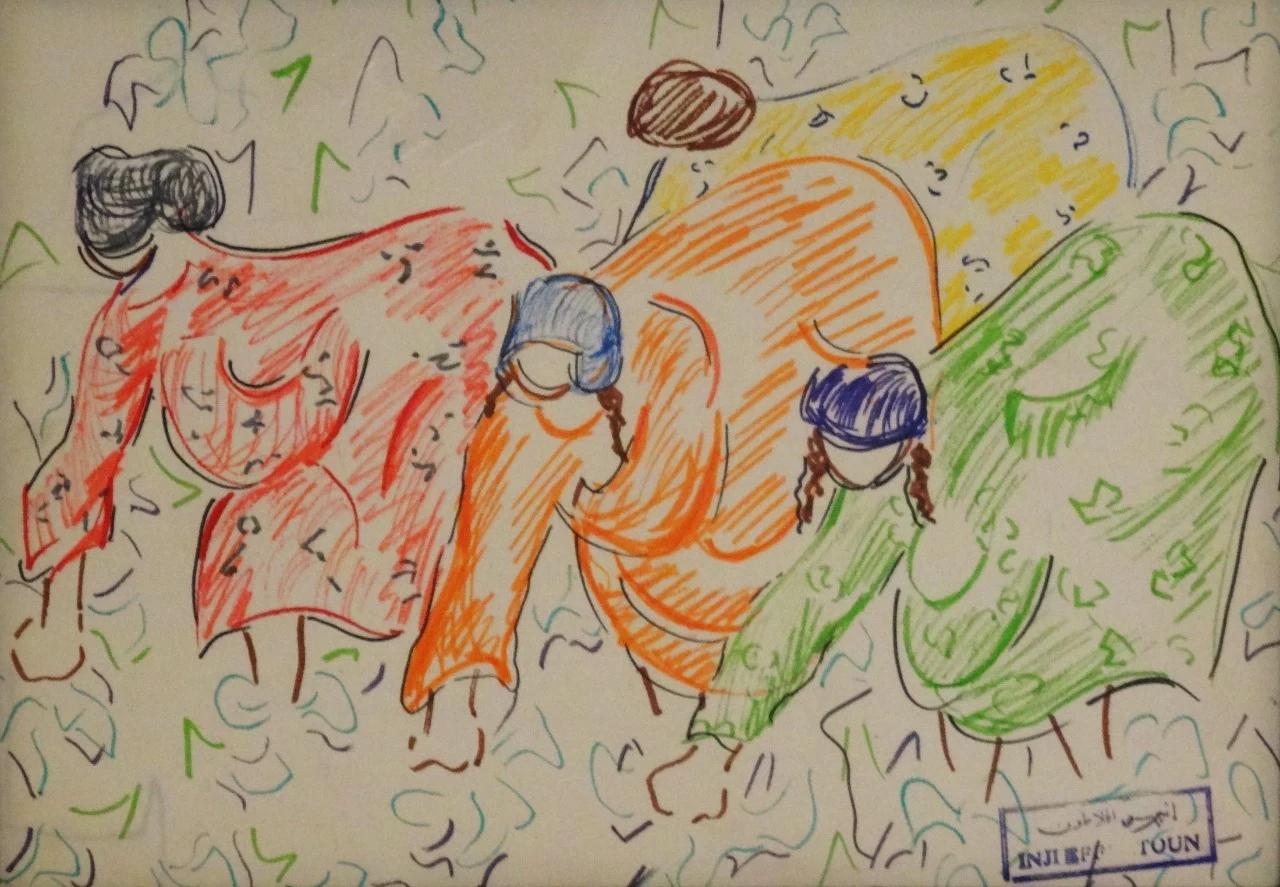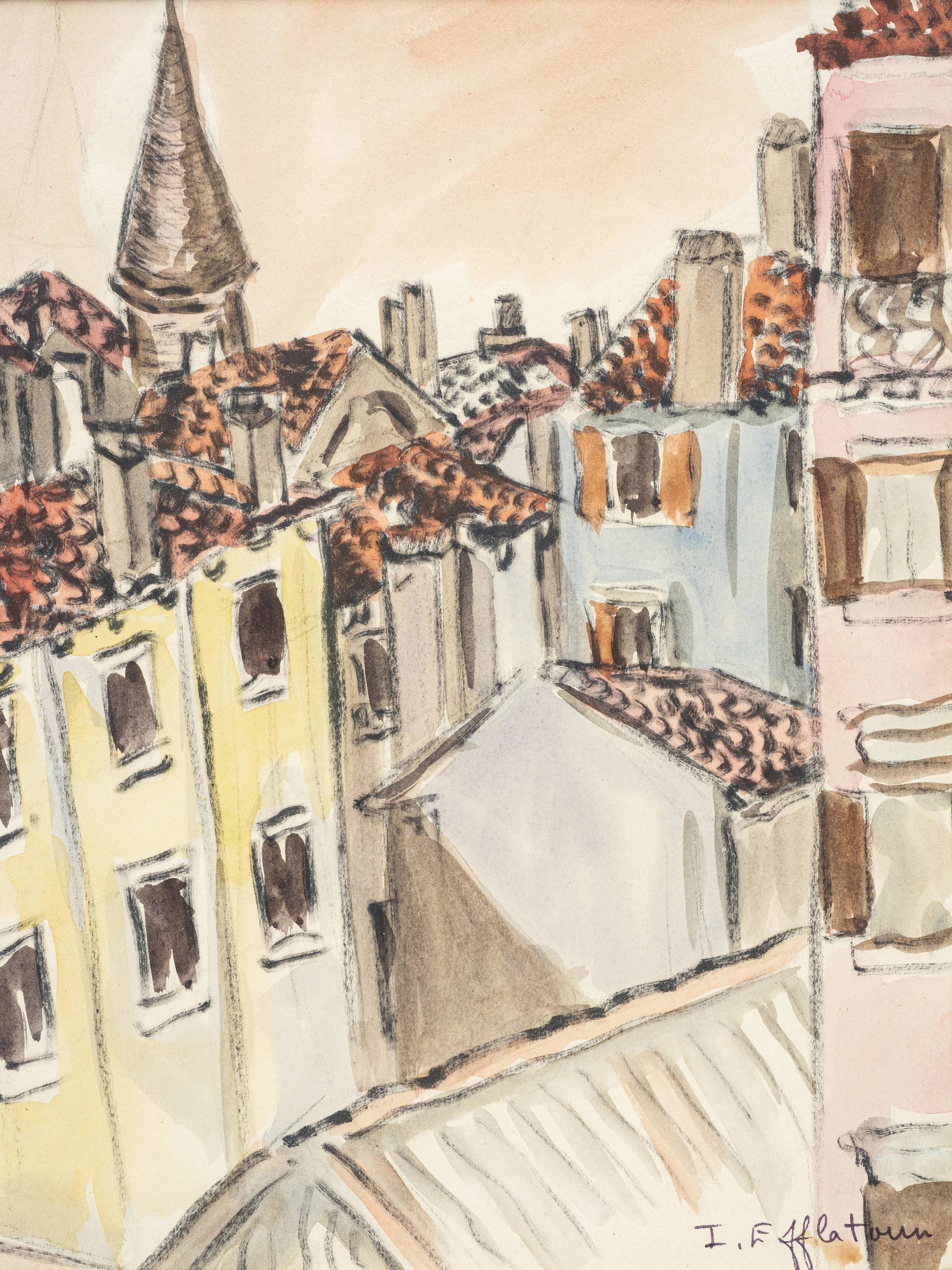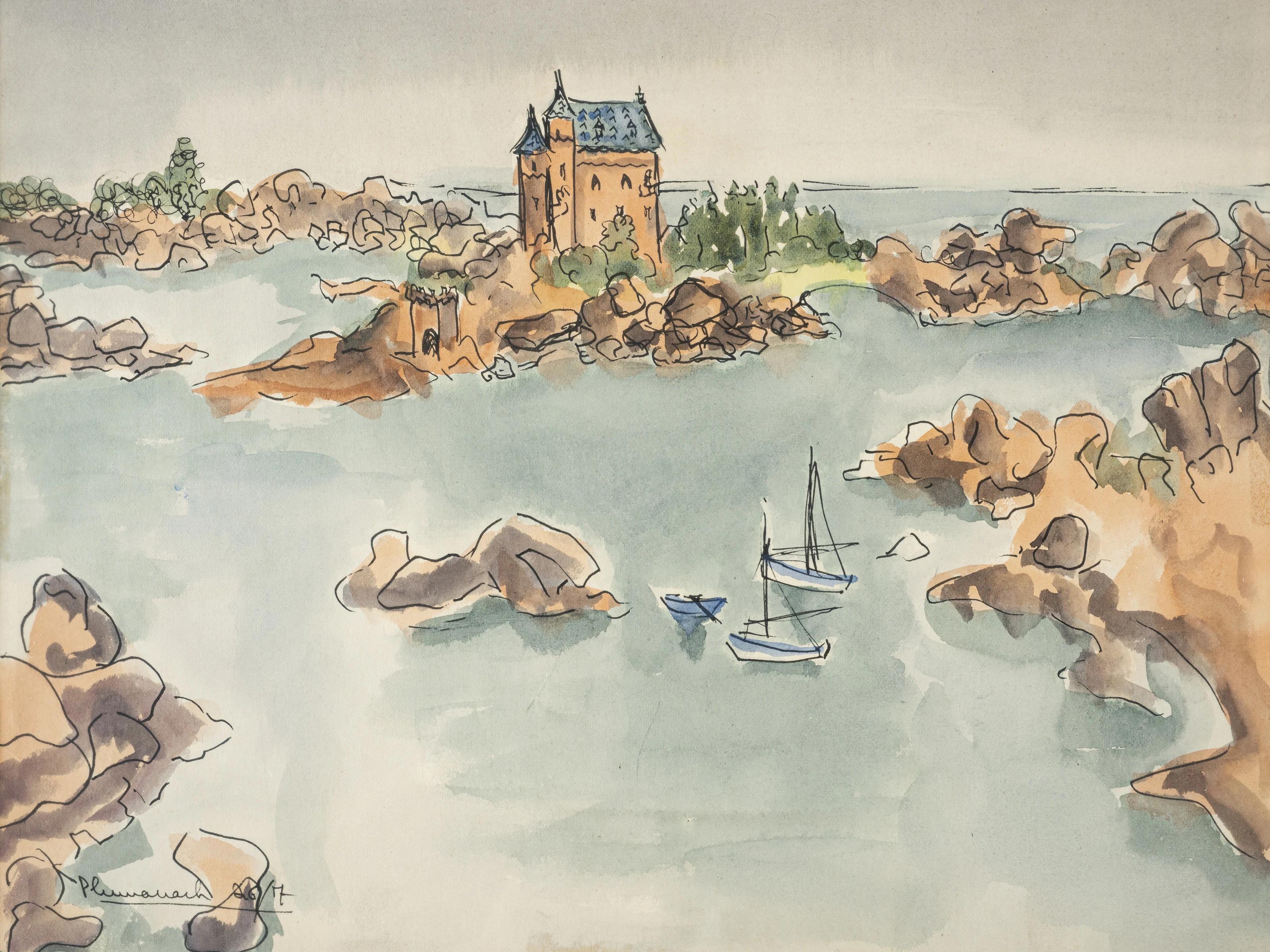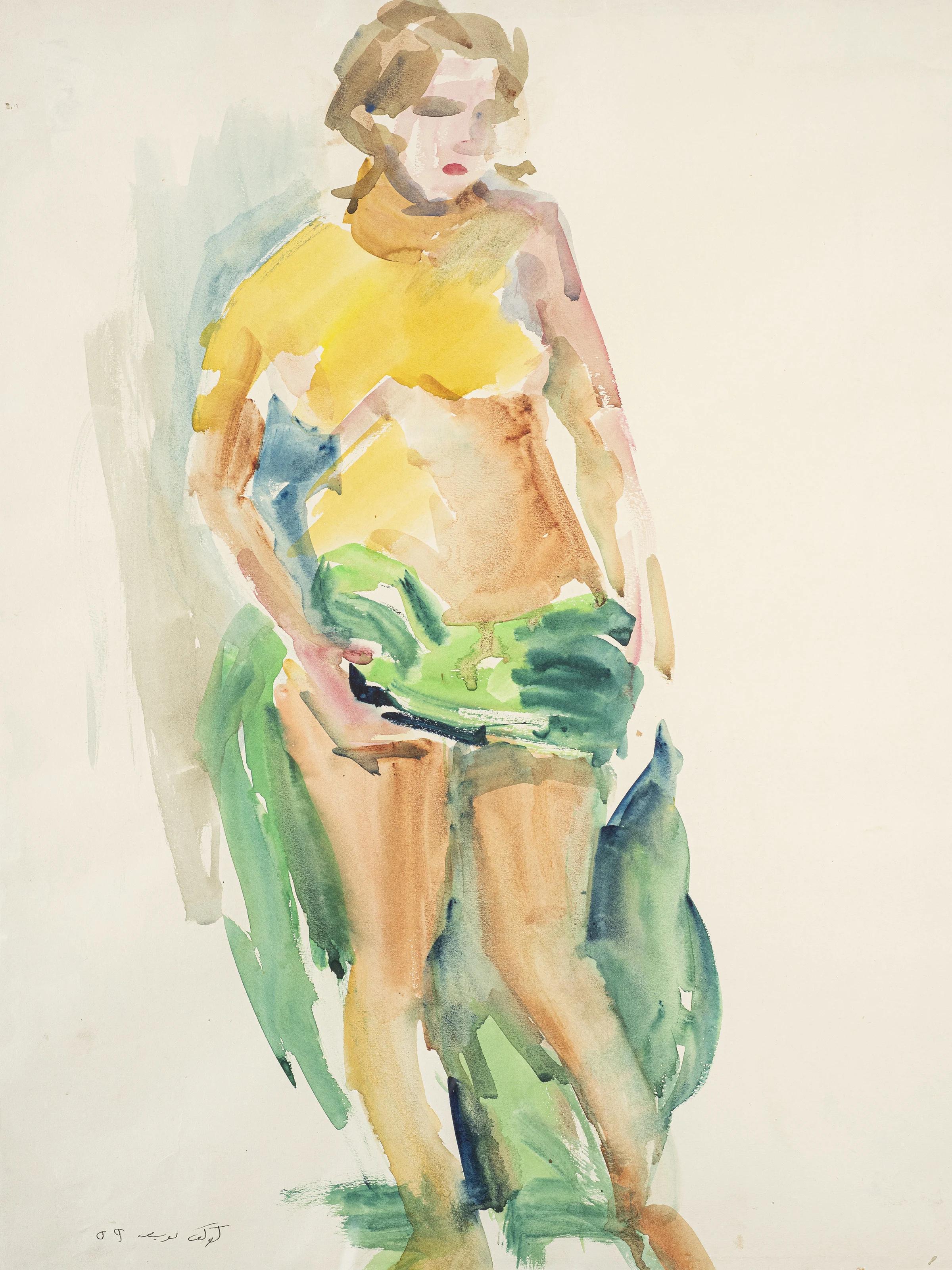Items Similar to "Seated Prisoner VI" Pencil on Paper Drawing 7.5" x 11" in by Inji Efflatoun
Want more images or videos?
Request additional images or videos from the seller
Inji Efflatoun"Seated Prisoner VI" Pencil on Paper Drawing 7.5" x 11" in by Inji Efflatouncirca 1960
circa 1960
About the Item
"Seated Prisoner VI" Pencil on Paper Drawing 7.5" x 11" in by Inji Efflatoun
Stamped
From the "Prison Period"
After transformative incident, Inji’s resolve to play a leading role in her country’s turbulent political environment was only strengthened, as she thrust herself into this progressive anti-establishment stance. In 1959, the most defining moment of Inji’s life came when she was imprisoned for four years, serving her sentence across a series of women’s prisons in the deserts surrounding Cairo. To this day, Inji’s prison years remain, in such an eventful and inspiring life, her most remarkable period, a legacy to not only her acumen as an artist but her exemplary and persevering nature as a human being above all else.
Critics as a result consider this period as having produced many of Inji most celebrated and emotionally challenging works. Her palette, manipulation of light and shadow, vivid expressionism and thoughtful subject matter all served to show her true ingenuity as an artist, as she became perfectly positioned to devote her talents to her most dearly-held personal convictions as an inmate amongst women prisoners serving time for disparate, although also presumably unjust, reasons. The paintings of this period embodied a candid emotional quality that seeped out of these canvases portraying the grim realities of prison life, not least for women in Nasser’s Egypt.
The ever-present cell bars became a frequent motif across these works, adding a depth of perspective yet simultaneously a pronounced separation between the viewer and the subjects of these works. Another constant motif that Inji would repeatedly portray was the ‘Inji Tree,’ which she painted a multitude of times often in different colors and mediums. This arboreal subject which would always appear as a similar rendition of the same tree became subsequently known as the ‘Inji Tree’ since it was the only tree she could see outside of her small cell window while incarcerated. As a result, Inji habitually returned to depicting this motif as a meditative practice as she sought to find what little beauty and optimism there was to cling onto during these trying years.
The works that Inji produced throughout this time are often considered to be the highlight of her career partially due to their value as documentary evidence and perhaps also because they are testament to her struggle and survival during incarceration. Although a cruel and unforgiving experience, for Inji, her prison period as it so happened, became the perfect vehicle through which to demonstrate most impactfully and poignantly the plight of Egypt’s disadvantaged, impoverished and discriminated in a way that solidified her pioneering status as Egypt’s first female artist-activist.
ABOUT THE ARTIST:
Inji Eflatoun pursued free studies in art. Since 1942, she has participated in the exhibitions of the Avant grade "Art and Freedom Group". This was the first society that attempted to free modern Egyptian art from the bonds of academism and formalism prevailing then.
In March 1952, she had her first one-person exhibition in Cairo and since then, she held 28 solo shows in Egypt and abroad. She has exhibited in Rome in 1967, at the "Paese Nove" gallery, in Paris at the "Galerie de l’Universite" in Dresden, East Germany, Warsaw, Poland, Moscow, and Prague. She held a one-person show in 1979, in New Delhi, India, in 1981 at the Egyptian Academy in Rome, and in 1988 in Kuwait. She has also participated in group exhibitions such as the Biennale of Sao Paolo in 1953, the Biennale of Venice in 1968, and the Contemporary Egyptian Art exhibition in Paris in 1971.
In 1975, Mrs. Eflatoun helped organize the "Ten Egyptian Woman Artist in half a Century" exhibition, held in Cairo on the occasion of the International year for woman, and in which she took part. In 1976 she was in charge of the Egyptian Pavillion at the 87th "Salon des Independants" in Paris, in the Grand Palais.
The artist’s works were acquired by the Modern art Museum in Cairo, in Alexandria, and in Dresden, the National Museum in Warsaw and by the Oriental Museum in Sophia, the Pushkin Museum in Sophia, the Pushkin Museum in Moscow, the Italian Deputies Council and by private collectors in Egypt and abroad.
In 1986, she was awarded by the French Ministry of Culture a medal of merit called "Cavalier of the Arts and Literature".
Inji Eflatoun died in 1989.
- Creator:Inji Efflatoun (1924 - 1989, Egyptian)
- Creation Year:circa 1960
- Dimensions:Height: 7.5 in (19.05 cm)Width: 11 in (27.94 cm)
- Medium:
- Movement & Style:
- Period:
- Condition:
- Gallery Location:Culver City, CA
- Reference Number:1stDibs: LU1085113394992
Inji Efflatoun
Inji Eflatoun pursued free studies in art. Since 1942, she has participated in the exhibitions of the Avant grade "Art and Freedom Group". This was the first society that attempted to free modern Egyptian art from the bonds of academism and formalism prevailing then.
In March 1952, she had her first one-person exhibition in Cairo and since then, she held 28 solo shows in Egypt and abroad. She has exhibited in Rome in 1967, at the "Paese Nove" gallery, in Paris at the "Galerie de l’Universite" in Dresden, East Germany, Warsaw, Poland, Moscow, and Prague. She held a one-person show in 1979, in New Delhi, India, in 1981 at the Egyptian Academy in Rome, and in 1988 in Kuwait. She has also participated in group exhibitions such as the Biennale of Sao Paolo in 1953, the Biennale of Venice in 1968, and the Contemporary Egyptian Art exhibition in Paris in 1971. In 1975, Mrs. Eflatoun helped organize the "Ten Egyptian Woman Artist in half a Century" exhibition, held in Cairo on the occasion of the International year for woman, and in which she took part. In 1976 she was in charge of the Egyptian Pavillion at the 87th "Salon des Independants" in Paris, in the Grand Palais.
The artist’s works were acquired by the Modern art Museum in Cairo, in Alexandria, and in Dresden, the National Museum in Warsaw and by the Oriental Museum in Sophia, the Pushkin Museum in Sophia, the Pushkin Museum in Moscow, the Italian Deputies Council and by private collectors in Egypt and abroad.
In 1986, she was awarded by the French Ministry of Culture a medal of merit called "Cavalier of the Arts and Literature". Inji Eflatoun died in 1989.
About the Seller
4.7
Gold Seller
These expertly vetted sellers are highly rated and consistently exceed customer expectations.
Established in 2016
1stDibs seller since 2018
358 sales on 1stDibs
Typical response time: <1 hour
- ShippingRetrieving quote...Ships From: Cairo, Egypt
- Return PolicyA return for this item may be initiated within 7 days of delivery.
More From This SellerView All
- "Harvest" Pencil Drawing 8" x 12" in by Inji EfflatounBy Inji EfflatounLocated in Culver City, CA"Harvest" Pencil Drawing 8" x 12" in by Inji Efflatoun Stamped Unique work. Inji Eflatoun pursued free studies in art. Since 1942, she has participated in the exhibitions of the Av...Category
20th Century Post-War Figurative Drawings and Watercolors
MaterialsArchival Paper, Pencil
- "Dinshaway Massacre VI" Pencil on Paper Drawing 7.5" x 11" in by Inji EfflatounBy Inji EfflatounLocated in Culver City, CA"Dinshaway Massacre VI" Pencil on Paper Drawing 7.5" x 11" in by Inji Efflatoun Stamped From the "Prison Period" After transformative incident, Inji’s resolve to play a leading ro...Category
20th Century Post-War Figurative Drawings and Watercolors
MaterialsArchival Paper, Pencil
- "Upper Egypt Musician" Colored Pencils drawing 13" x 9" in by Inji EfflatounBy Inji EfflatounLocated in Culver City, CA"Upper Egypt Musician" Colored Pencils drawing 13" x 9" in by Inji Efflatoun Stamped Unique work. Inji Eflatoun pursued free studies in art. Since 1942,...Category
20th Century Post-War Abstract Drawings and Watercolors
MaterialsArchival Paper, Pencil
- "Sarlat II" Watercolor on Paper 12" x 8" inch by Inji EfflatounBy Inji EfflatounLocated in Culver City, CA"Sarlat II" Watercolor on Paper 12" x 8" inch by Inji Efflatoun circa1950 Signed Inji Eflatoun pursued free studies in art. Since 1942, she has participated in the exhibitions of ...Category
20th Century Post-War Abstract Drawings and Watercolors
MaterialsWatercolor, Archival Paper
- "Ploumanac'h I" Watercolor on Paper 9" x 12.5" inch by Inji EfflatounBy Inji EfflatounLocated in Culver City, CA"Ploumanac'h I" Watercolor on Paper 9" x 12.5" inch by Inji Efflatoun circa1950 dated Inji Eflatoun pursued free studies in art. Since 1942, she has participated in the exhibitions...Category
20th Century Post-War Abstract Drawings and Watercolors
MaterialsWatercolor, Archival Paper
- "Robed Woman" Watercolor Painting 24" x 16" inch (1959) by Kawkab YoussefLocated in Culver City, CA"Robed Woman" Watercolor Painting 24" x 16" inch (1959) by Kawkab Youssef Signed and dated 1959 A short history of Kawkab Youssef El-Assal: With a s...Category
20th Century Post-War Figurative Drawings and Watercolors
MaterialsPaper, Watercolor
You May Also Like
- Moon DancerLocated in London, GBDiscover the enthralling "Moon Dancer" drawing crafted by Rafael Melendez in 2020. This medium-sized drawing on paper seamlessly fuses various art forms, epitomizing the artist's rem...Category
2010s Contemporary Abstract Drawings and Watercolors
MaterialsGesso, Acrylic Polymer, Watercolor, Pencil, Archival Paper
- Yemen (Coffee Plant): Green Abstract Colored Pencil Drawing, FramedBy Andrea MoreauLocated in Hudson, NYGreen Abstract figurative drawing on paper with found postage stamp 'Yemen (Coffee Plant)' by Andrea Moreau, 2012 colored pencil and postage stamp on pape...Category
2010s Contemporary Abstract Drawings and Watercolors
MaterialsFound Objects, Archival Paper, Color Pencil
- "Transition, Series 1, No. 4" - Watercolor Figurative IllustrationLocated in Soquel, CASubtly shaded abstract figurative illustration by Elsa Warnick (American, 1942-2013). Two adult and three baby figures are rendered with subtle tan shading, against an abstract background with geometric shapes and swirling ribbons. One of the two adult figures is laying down, while the other appears to be jumping or dancing. Notable is the skillful use of negative space to balance the composition. Signed and dated "Warnick 1982" in the lower right corner. Signed, titled, and dated with materials information on verso. Presented in a silver aluminum frame. Frame size: 23.5"H x 31.25"W Paper size: 23.25"H x 31"W Elsa Warnick (American, 1942-2013) was born and raised in Tacoma, Washington. She moved to Portland to attend the Reed College/Museum Art School joint five year program. Warnick went on to create many works of art as well as teach art and illustration. She is mostly known for her watercolor paintings, including the illustration of several children's books. Some of her pieces are held in the Portland Art Museum’s collection. Selected Exhibitions: 1974: University Center Gallery, Willamette University - Salem, OR 1978: Mayer Gallery...Category
1980s American Modern Figurative Drawings and Watercolors
MaterialsPaper, Watercolor, Pencil
- Kyle Andrew Szpyrka - Learning to FlyBy Kyle Andrew SzpyrkaLocated in Greenwich, CTSutra, a Sanskrit word meaning “thread”, is a word or small group of words that summarize an entire complex web of ideas, truths, wisdoms, or teachings all woven together into a sing...Category
21st Century and Contemporary Surrealist Figurative Drawings and Waterco...
MaterialsPaper, Foam Board, Pencil, Graphite
- Kyle Andrew Szpyrka - LotusBy Kyle Andrew SzpyrkaLocated in Greenwich, CTSutra, a Sanskrit word meaning “thread”, is a word or small group of words that summarize an entire complex web of ideas, truths, wisdoms, or teachings all woven together into a sing...Category
2010s Surrealist Figurative Drawings and Watercolors
MaterialsPaper, Pencil, Graphite
- German Neo Expressionist Graphite Pencil Drawing Erwin Pfrang Nolan Gallery NYCLocated in Surfside, FLErwin Pfrang, German (b. 1951) Graphite Pencil on paper Framed 20 X 20.5, sheet 12.5 X 13 Hand signed lower left Erwin Pfrang (born 1951, in Munich) is a German painter and printmaker. Pfrang studied at the Academy of Fine Arts in Munich from 1974–79. Later he spent many years as an independent artist in Montepulciano, Val d’Orcia and Catania, Italy, interrupted by stays in Munich and Augsburg. He presently lives and works in Berlin. Erwin Pfrang is the grandson of the Munich folk comedian Konstantin Pfrang. Carla Schulz-Hoffmann makes an attempt at characterising the painter: “An artist such as Erwin Pfrang inhabits an alternative world, a tiny microcosm of subjectivity, and lives that life uncompromisingly, with all the limitations and hardships that it entails. Among twentieth-century artists a comparable stance can be encountered perhaps in Jean Fautrier, but certainly in Otto Wols. His oeuvre relates in its figuration to Bosch or James Ensor and his oil painting to Lucian Freud in its painterly quality. Erwin Pfrang is represented by gallerists Fred Jahn, Munich (Exhibition: Don’t Forget Your Mask: Don’t (Part I: Don’t Forget Your Mask), Forget (Part II: Don’t Forget Your Mask), Your Mask (Part III: Don’t Forget Your Mask)Artists: Imi Knoebel, Barry Le Va, Karel Appel, Alexi Tsioris, William N. Copley, Isa Genzken...Category
Early 2000s Neo-Expressionist Figurative Drawings and Watercolors
MaterialsPaper, Pencil, Graphite
Recently Viewed
View AllMore Ways To Browse
Chanel Sketches
Adolf Reinhold Hallman
Nudo Femminile
Circus Charlie
Angelina Beloff
Rudolf J Weiss
Whitman Sofa
Life Size Bronze Figure
Joan Miro Unique
Kentucky Signs
Hotel Sketch
Solid Pattern Painting
Going Towards The Light
Large Kelly
Chinese Cut Paper
Boats On Beach Oil Painting
Saturday Evening Post Magazine
Lincoln Center Editions






